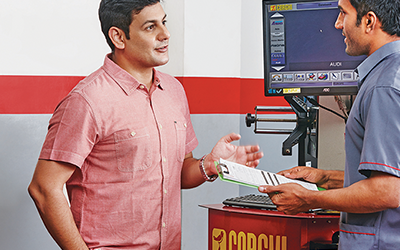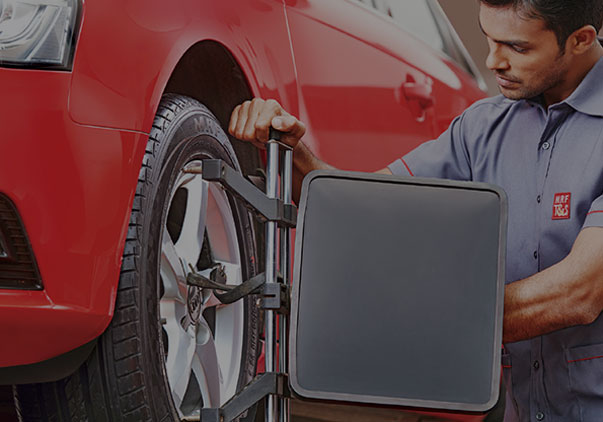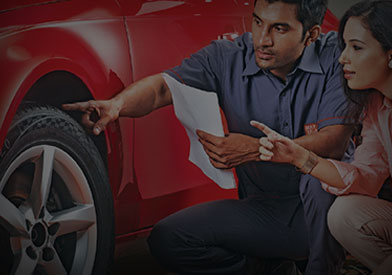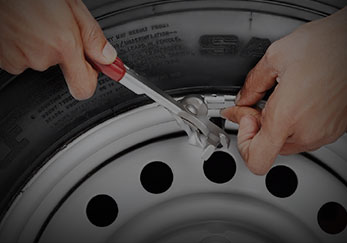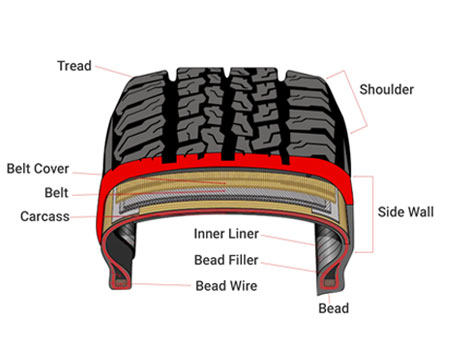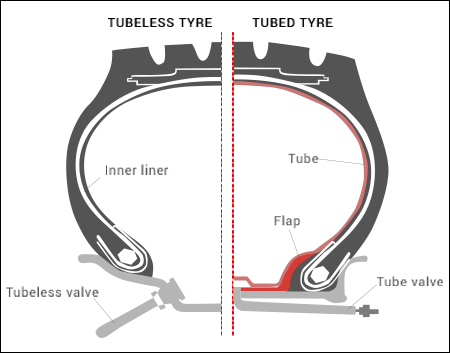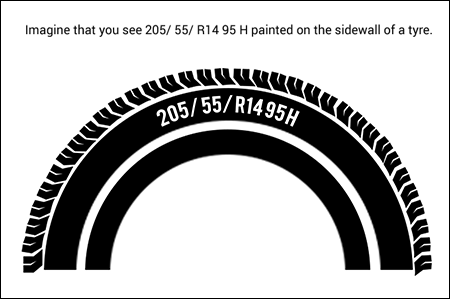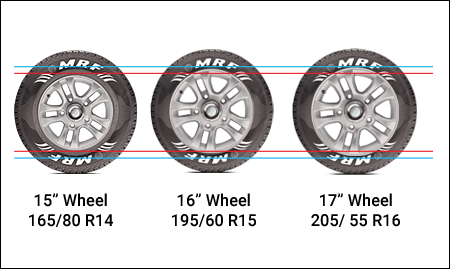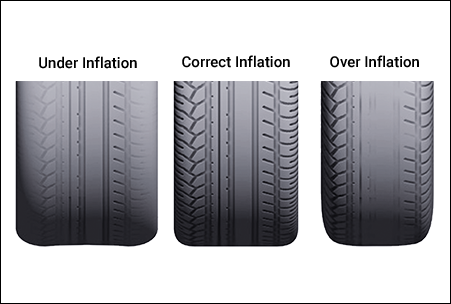Maintaining tyres
- Checking tyres for wear
- fixing punctures
- tyre rotation
- nitrogen inflation
- wheel alignment
- wheel balancing
Tyres are the main point of contact between the road and the car. Just like a pencil tip wears when used, so do tyres. Worn tyres can reduce grip, fuel efficiency, and can cause accidents. So this is how you can check if your tyres are worn out:
- Every tyre has a Tread Wear Indicator, which looks like an upward-pointing arrow.
- If the outer wall of a tyre touches the tip of the indicator, it must be replaced.
- Tyres must have a minimum of 2mm tread depth left, to be effective.
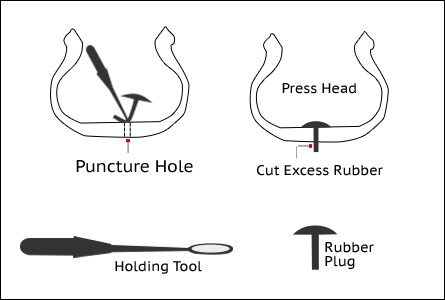
In many places across India, the roads are not properly laid out. Bad news for tyres? Yes! Absolutely. Broken pieces of tarmac, debris from road accidents, rusted bits of construction material litter our roads everywhere. Add to this potholes and you have a destructive mix leading to tyre punctures. So what do you do when you suffer a flat tyre? Keep in mind these points.
- As far as possible, fixing punctures without trained assistance is not recommended.
- In case there is a puncture, stop the car, park it at the side of the road and turn on your hazard lights.
- Check where the puncture has occurred.
- Once done, use the vehicle jack to lift the car.
- Loosen the wheel lugs first, then remove them.
- In case you have a doubt, consult an MRF T&S for help.
- You can find out the location of a T&S near you by going to www.mrftyres.com
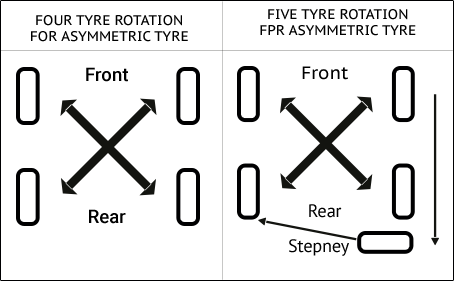
In test cricket you will notice that the fielding team’s captain keeps changing his bowlers after brief spells. This not only helps the bowlers recover their energy but also keeps the batsmen on their toes because of the fresh bowlers in the attack. Interestingly, this concept can also be applied to tyres. Most cars in India are front wheel driven, which means that the front wheels wear out faster than the rear. This can cause serious handling problems. To tackle this, tyres need to be swapped, or rotated every 5000 km. Every manufacturer provides the rotation schedule in schedule in the user’s manual.
- The main reason why tyres are rotated is to ensure equal wear on all the tyres.
- Most cars in India are front-wheel driven, so the wear on the front wheels is more than that on the rear.
- Tyres must be rotated every 5000 km
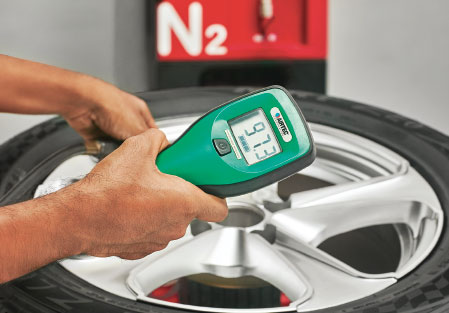
Just like you like wearing cool shades, wearing a cool jacket and having that cool hair-do, there is a way to make your tyres cool as well? How? Nitrogen. Yes the same gas that makes up 78% of air. Nitrogen is an inert gas, so it does not expand as much as air when your tyres get heated up. Not only that, Nitrogen does not contain any water molecules, which protects the rim in the long run. Since the gas molecules are larger, tyre pressure is maintained over a longer period of time compared to air. In case you didn’t know, Nitrogen is used to inflate tyres used for fighter jets and race cars. Think about it.
- Inflating your tyres with Nitrogen prevents sudden blowouts.
- Nitrogen molecules are larger, meaning that it cannot escape from microscopic pores in the tyre, whereas air can.
- This means that Nitrogen‑inflated tyres lose less pressure than air over the same period of time.
- Nitrogen is lighter than air, which leads to fuel savings.
- Every MRF T&S is equipped with a state‑of‑the‑art nitrogen generator which ensures that only 95.5% pure nitrogen is used for your tyres.
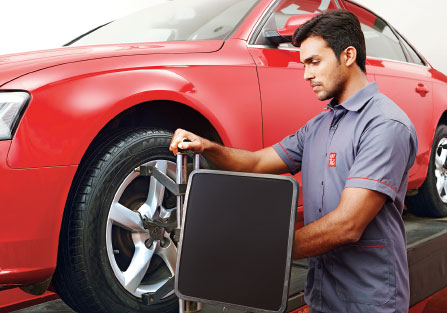
The next time you go for a walk, have a look at your feet. No seriously, stop and look at your feet. You will notice that they are curved. Why so? That is because when you stand, your body weight flattens it. This helps you walk straight. The same applies to your car’s wheels. When a car is loaded, you will notice that it dips a bit for a fraction of a second. This is because the extra load is transmitted to the suspension, which then pushes down on the wheels. This causes the wheels to move outwards slightly. This is so that the load gets evenly distributed among all four wheels via the tyres. This setting however, is disturbed by bad roads and potholes. Your car will start pulling to one side while driving if your wheel alignment is off. Even if your car steers properly, it is always a good practice to get your wheels aligned every 5-8000 km and when you have bought a new set.
- Wheel alignment is done regularly in order to ensure proper handling, equal tyre wear and reduced load on the suspension.
- There are three parameters to be considered while getting your wheels aligned: caster, camber and toe angle.
- Caster is calibrated to improve steering feedback.
- Camber is adjusted to improve handling.
- Toe angle is dependent on the camber and is calibrated to ensure equal tyre wear.
- Wheel alignment should be done every time new tyres are fitted.
- Every manufacturer provides wheel alignment data, and it is recommended to adhere to the same.
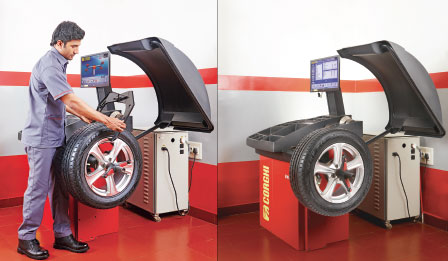
Ever been on a merry-go-round when young? Imagine if a group gets on one side when you are alone on the other side. What will happen? The merry-go-round will tilt to one side when it rotates. To compensate it, you bring on board another kid. And another. Till there is perfect balance. This is exactly what happens during wheel-balancing. Wheel balancing is done when there are vibrations at high speed. The wheels are removed, and then weights are attached to the rim till the rotation is perfectly balanced. It is very important to get your wheels balanced every time you get a new set of tyres.
- Wheel balancing is done to prevent vibrations at high speed.
- If not done , an unbalanced wheel set up can drastically hamper ride quality.
- Wheel balancing should be done every time you go in for a tyre service/repair/replacement.



